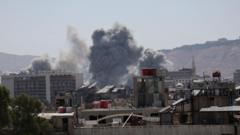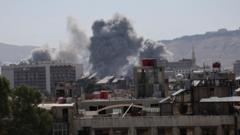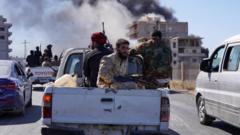The United States is reducing its military presence in Syria as the landscape continues to evolve post-Assad, raising concerns about the resilience of the Islamic State amid geopolitical changes.
U.S. Troops Begin Withdrawal from Syria Amid Changing Dynamics

U.S. Troops Begin Withdrawal from Syria Amid Changing Dynamics
The drawdown of American forces follows significant political shifts in Syria, including the potential for new governance.
The United States has initiated the withdrawal of several hundred troops from northeastern Syria, reshaping its military strategy in light of the political changes following the fall of President Bashar al-Assad in December. This reduction affects three of the eight American operating bases in the region, reducing troop levels from approximately 2,000 to about 1,400.
Officials have disclosed that American military leaders plan to assess the situation after 60 days to determine if additional cuts should be considered. Although there are proposals to maintain a contingent of at least 500 U.S. personnel, President Trump's reservations about sustaining any military presence in Syria remain a critical factor in future decisions.
Despite the diminishing influence of Assad’s regime, which has led to a decrease in various threats such as Iranian-backed militias and Russian forces in Syria, the Islamic State continues to pose a significant danger, particularly in the northeastern region where U.S. troops are primarily stationed. The recent political developments, including an agreement for the Kurdish-led militia in northeastern Syria to merge with the newly formed government, signify an important step towards unifying the country, even as Syria grapples with ongoing violence.
The realignment of U.S. forces in Syria is reflective of broader shifts in the region, carrying implications for both security and political landscapes amidst ongoing tensions.
Officials have disclosed that American military leaders plan to assess the situation after 60 days to determine if additional cuts should be considered. Although there are proposals to maintain a contingent of at least 500 U.S. personnel, President Trump's reservations about sustaining any military presence in Syria remain a critical factor in future decisions.
Despite the diminishing influence of Assad’s regime, which has led to a decrease in various threats such as Iranian-backed militias and Russian forces in Syria, the Islamic State continues to pose a significant danger, particularly in the northeastern region where U.S. troops are primarily stationed. The recent political developments, including an agreement for the Kurdish-led militia in northeastern Syria to merge with the newly formed government, signify an important step towards unifying the country, even as Syria grapples with ongoing violence.
The realignment of U.S. forces in Syria is reflective of broader shifts in the region, carrying implications for both security and political landscapes amidst ongoing tensions.




















